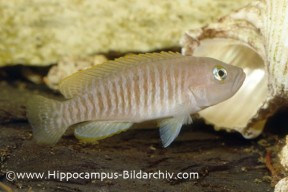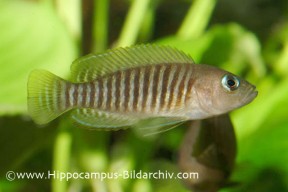Neolamprologus multifasciatus
Classification
Cichlidae. Subfamily: Pseudocrenilabrinae
Distribution
Endemic to Lake Tanganyika.
Habitat
It inhabits fairly deep water around the shoreline. These areas are characterised by soft substrates, where the empty shells of snails collect.
Maximum Standard Length
Male to 1.8″ (4.5cm). Female to 1.4″ (3.5cm).
Aquarium SizeTop ↑
18″ x 12″ x 12″ (45cm x 30cm x 30cm) – 40 litres for a pair. A larger tank is required for a colony.
Maintenance
The aquarium should have large open areas of sandy substrate, to which should be added a good number of empty snail shells (see breeding section below). More shells should be provided than there are individual fish. The substrate should be at least 2″ deep as the species likes to dig.
Water Conditions
Temperature: 75-81°F (24-27°C)
pH: 7.5-9.0
Hardness: 8-25°H
Diet
Live and frozen varieties should form the bulk of the diet, although dried foods are usually accepted.
Behaviour and CompatibilityTop ↑
A territorial fish that will defend its shell and the small territory around it vigorously. It can be combined with other species that inhabit other areas within the tank. Good tankmate choices include small rockdwellers such as Neolamprologus brichardi or smaller species of Julidochromis and open water species such as Cyprichromis. If a number of fish are kept, it will form a colony. If keeping it in this type of situation make sure there are enough shells to go around and try to buy more females than males.
Sexual Dimorphism
Not easy to sex when young but adult males are considerably larger than females. They also have slightly more intense colouration and a reddish tint to the upper part of the dorsal fin.
Reproduction
Quite easy. Shell brooder. It may breed in the community tank but if you want to raise a full brood of these, a separate tank should be used. Set it up as suggested above. Provide plenty of snail shells, as the females will lay their eggs in these. Escargot shells are a good choice and can be obtained from most decent delicatessens. Water should be hard and alkaline with a pH of around 8.0-8.5 and a temperature of 77-80°F. Keep several females per male and spacing the shells out a little. This helps to reduce aggression between males. Males may also spawn with multiple females if they are available. Condition the fish on a varied diet of live and frozen foods.
Females will attempt to catch the attention of males by displaying at the entrance of their chosen shells, which they bury until only the entrance is visible. When a male is sufficiently interested, the female swims into the shell where she deposits her eggs. When she has finished, she begins to back out of the shell at which point the male releases his sperm. This is ‘sucked’ into the shell by the action of the exiting female, thus fertilising the eggs. Alternatively, if the shell is large enough the male may enter it before releasing his sperm.
After fertilisation the male plays no further part in brood care and is no longer welcome in the female’s territory. The female sits on the shell, covering the entrance and fanning the eggs with her fins. These hatch in around 24 hours, becoming free swimming at around the 6-7 day stage. The fry now start to make forays away from the shell, venturing further and further as they grow. Eventually they are evicted by the female after another fortnight or so.
The fry are big enough to accept brine shrimp nauplii or microworm once they become free swimming. It is probably better to remove them to a separate rearing tank at this stage to ensure the best survival rate. Although the parents do not usually harm them other fish in the colony may eat them.
NotesTop ↑
This is probably the smallest known cichlid species and exhibits truly fascinating behaviour. The territories it establishes are very small, usually measuring no more than 6″ across, but they are defended vigorously. The tiny fish will even bite hands or fingers that invade their ‘personal space’! Highly recommended to anyone wishing to observe some unique behaviour on a small scale.




April 13th, 2014 at 6:33 pm
The second picture I believe is actually Neolamprologus similis. Notice the difference in coloration and eye size.
Other than that, either species are wonderful to keep (N.similis getting a bit larger). I have a small colony in a 75GAL Bowfront Aquarium and they are rapidly reproducing and establishing large territories.
More interesting than TV!
April 11th, 2015 at 10:02 am
I own these fish an similis have their lines all the way past the gill plates. The second photo is most likely an older fish. I have noticed that the older the fish the darker they become. If you get them in the right light you can see flashes of purple under their eye an on their lips.
I love these fish, I have a 3ft tank that has only them in it. I love to pull up a chair an watch them defend their territories.
March 20th, 2017 at 10:53 am
I think the second photos is one in breeding condition. My females always flush darker like that when caring for eggs or young fry.